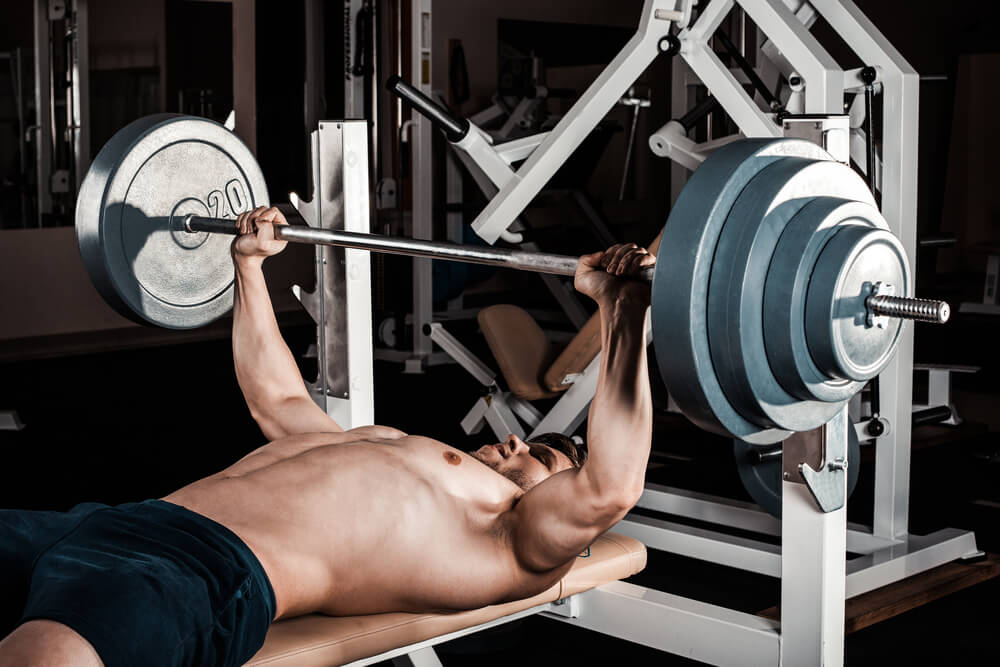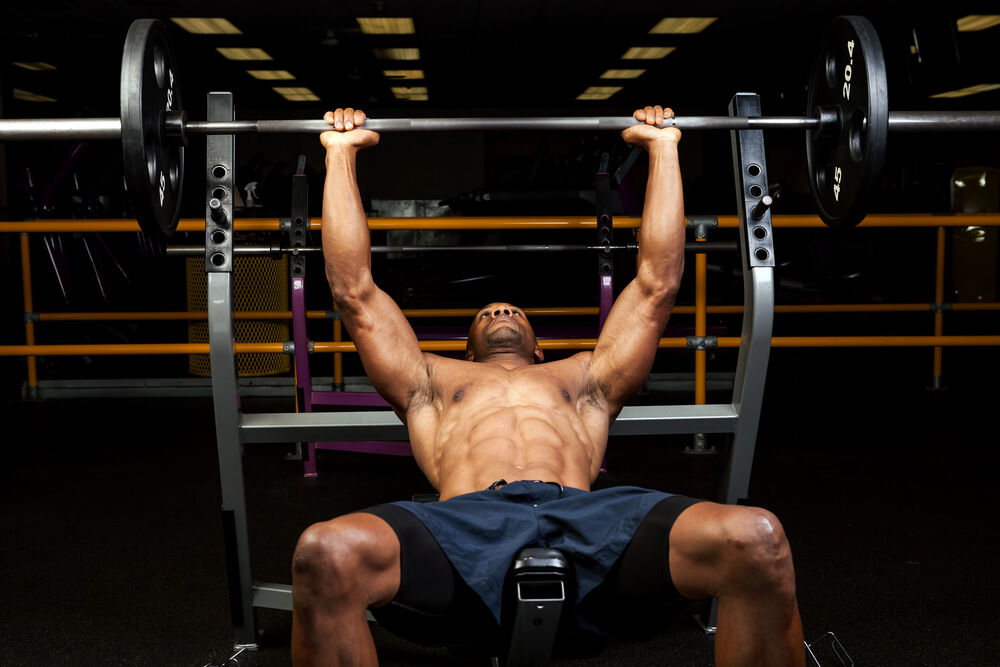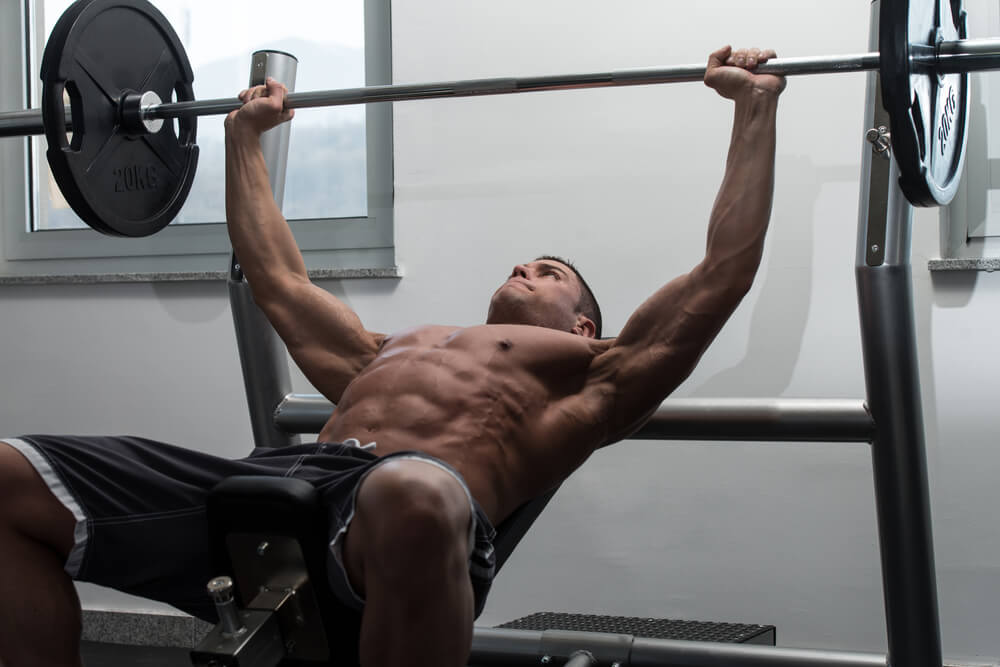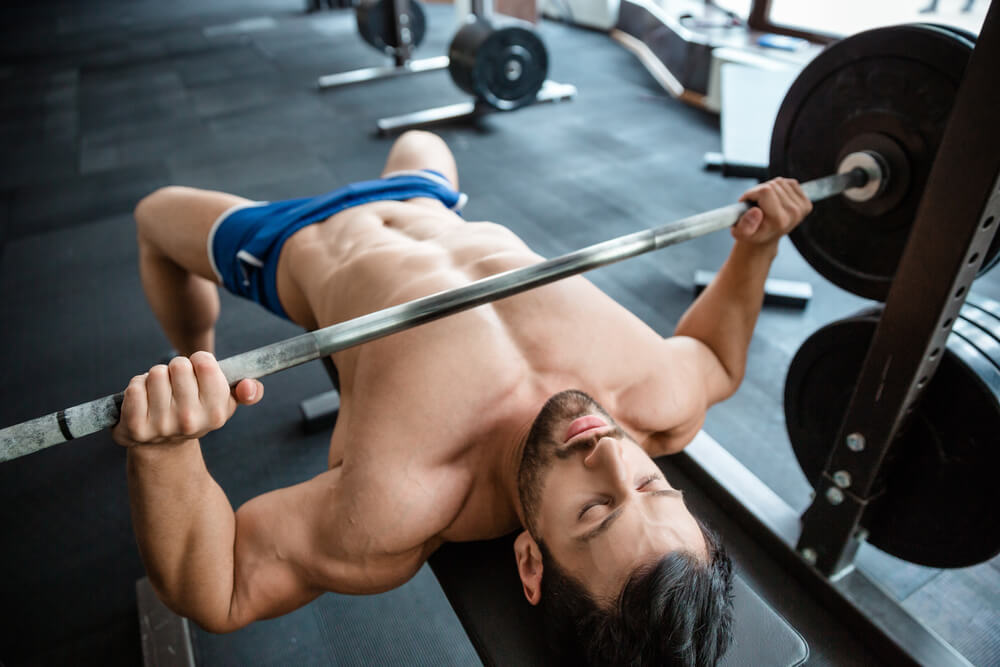
Arnold, The Rock, Hugh Jackman. What do they all have in common? Well, outside of showing up in Hollywood movies, these three have defined, large pectoral muscles. Each of these individuals also comes from a completely different background.
Arnold lifted professionally while Dwayne “The Rock” Johnson played some college football. Hugh Jackman comes from Australia and didn’t really become a major muscle showstopper until he took on the role of Wolverine.
So what does all of this mean?
It means that people from all walks of life and with different backgrounds can shred their pectoral muscles and really pack on the muscular definition and weight.
As one of the largest muscle groups in the body, you also don’t need to spend hours blasting away at your chest.
You just need a solid bench press program to spur on your gains. And, thankfully, we’ve got all you need to know right here.
The Bench Press Program For Your Gains:

Breaking Down the Chest Muscles
While it looks like one group of muscles, the pectoral region of your body is actually made up of two different muscle groups. It’s important to look into these different muscle groups as we can then pinpoint the best bench press exercises for each region.
The chest itself is made up of the pectoralis minor and the pectoralis major.
If you look in the mirror and flex your chest, you may see some rippling either where the pectoral muscles come together below your neck or where it reaches the shoulders. This is where the pectoral muscle groups separate.
The pectoralis major is the top portion of your chest, while the pectoralis minor is underneath and makes up about the lower third of your chest.
The pectoralis major, while a single group of muscle tissue, can be broken down further. This is into the sternal head and the clavicular head. If you place your finger at the base of your throat where the “u” shape in the bone is.
If you then trace over your pectoral, following the natural curve of the muscle, down to your armpit, you are separating the pectoralis major muscle.
Everything below this is the sternal head of the muscle. The small sliver of muscle above it is the clavicular head. Similar to training the major and minor portion of your chest, you will need to target this area as well.
In order to see the most size gains with your chest, it is important to train each area of the chest.
Thankfully, there are simple bench press variations that will help you with this.

The Three Benches
The beauty of the bench press is you can hit every section of your chest with the one exercise.
As the muscles do not curve around your body (such as your shoulders) you don’t need to throw in varying movements to properly hit your chest.
Instead, you need to alter the lift angle, which you can do by adjusting the bench press itself.
The traditional bench press does hit all three muscle groups of your chest.
However, the vast majority of the press hits the sternal head of your pectoralis major. There’s a reason why it is one of the most important lifts you can and will do.
Plus, it not only targets your chest but it hits most of your supporting upper body, including your shoulders, back, and arms.
It’s easy to see why the regular bench press hits the middle section of your chest. When you lift, you’re literally pushing the weight up from the middle of your chest.
With that said, you do leave the upper and lower portions of your chest open to under working. If all you do is the regular bench press and then move on to other upper body lifts, you’re leaving yourself short-changed and you’ll never see the kind of gains you want.
The second lift you need to use is the incline bench press.
This variation is basically a halfway point between a traditional bench press and a shoulder press, with the bench’s back positioned at around a 45-degree angle. This shift in lifting angle is enough to change the impact on your upper body though. You are now forced to lift the weight directly above the clavicular head.
While you still hit the main portion of the pectoral, the emphasis is on the clavicular head, making it a must if you really want to take the bench press and turn it into a size and strength gaining lift.
The third of the three benches is the decline bench. With the bench dropped down, the emphasis of the lift is shifted to the pectoralis minor. This hits the lower portion of your chest.
By utilizing all three of these bench press variants, you’ll see a dramatic improvement in not only your size but your strength as well.
Bench Press Weight Types
There are a few different ways to perform these three bench lifts, but the best will always be using the unassisted barbell.
Dumbbells do come in second, and while these are great for building individual strength for each side of your body, it reduces the total amount of weight you can put up (there’s a reason why football players out of college bench press a barbell at the Combine to demonstrate upper body strength instead of dumbbells).
If you’re working out at home and must rely on dumbbells there’s nothing wrong with that. We’ll even go into how you can get the most out of lighter weight in a little bit (yes, it really is possible to boost size gains with lighter weight).
In general, there are two variations of lifting we’re going to tell you to avoid whenever possible. The first is the Smith machine.
While still technically a “barbell”, this lift offers a support feature the regular barbell and dumbbell do not have. With the free weights, you do not have the added support, which helps strengthen the stabilizer muscles.
Removing stabilizer assistance will reduce potential gains and shortchange your training. That is why we also recommend avoiding the bench press machines.
Of course, there are times where there isn’t any way around it. Many of the most popular gym chains offer only machines, so if you are part of these gyms use what you have access to. Machines for chest free are also amazing for beginners and advanced gym-goers. Click here for ideas for machine workouts.
But in general, if there is an option, use barbell first and dumbbells second.

Performing Your Lifts
Chances are, you’ve put up a few sets of the chest press before. But let’s go over it a bit just to cover the basics.
First, let’s look at hand placement.
The goal here is to target your chest, so you’ll want a hand placement of a little more than shoulder-width apart. A closer grip will shift more of the weight to your arms. If the barbell you’re using has a finger guide, use it. This is a good focus point for placing your hands.
Now, don’t go too far out with your grip. Anything more than slightly more than shoulder width apart will place the focal point onto your shoulders.
Place the barbell onto the rack above the bench so there’s enough space for you to lift it without fully extending your elbows. Fully extending your elbows on lifting will put you at risk of the elbows locking.
During the lift, don’t just let the weight drop down toward your chest. Instead, let it down slowly. This actually targets your back as you put lower the weight slowly. Lifting slowly is a good way to see size gains as you’re putting extra strain on the muscle fibers. So let the weight down slowly.
Now, some people will let the barbell touch their chest, others will stop right above the chest. The idea of letting it touch your chest is to have an endpoint of the lift.
It also ensures the greatest stretch on your pectoral muscles, which increases the muscle tear and size gains.
If you do go with this method do not rest the barbell on your chest. Explode up immediately. We actually like slowing it down and stopping the lift as close to the chest as possible without actually touching the chest. This forces additional stabilizers to engage. It also maintains constant pressure on the muscles. It’s up to you, but keep this in mind.
We also suggest to not lock your arms when pushing the weight up fully.
Instead, stop the pushing up motion just before your elbows lock. This maintains strain on your chest while helping you avoid the dreaded elbow lock.
Weights and Sets
Let’s focus on sets first. The regular bench press is the most important lift of the three. So you’ll want to do it four times. Hit the other two lifts three times.
We would also say perform the regular bench press first, then alternate between incline and decline every week. So on the first week, perform bench, incline then decline.
On the second week, perform bench, decline, then incline.
Now, what kind of weight should you focus on?
It depends what kind of gains you’re going for.
If you want strength gains, shoot for four reps per set.
So let’s say you’re able to put up four reps on your first set. On your next set increase the weight. Continue putting on weight until you can’t get it up four times.
It is important to not stop if you still have energy in the tank though. So if you reach four reps but still have more energy, put up as many as you can. You’re shortchanging yourself if you don’t push your body to failure.
If, on the other hand, you’re shooting for size gains, you want to put up more reps. The sweet spot is right between eight and 12 reps. As is the case with strength gains, if you can put up 12 or more reps it’s time to increase the weight.
If you can’t hit eight reps decrease the weight.

Size Gains With Lighter Weight
Okay, so maybe you don’t have a gym membership so have to do the lifting at home. And perhaps you don’t have the kind of weight you need to really focus on your size gains. There is a way around this. You won’t be able to increase strength gains, as strength gains only come with lifting more weight.
However, you can gain size with lighter weight.
With your lighter weight, you still want to focus on eight to 12 reps.
But how do you do this with lighter weight?
Lift slowly.
Instead of exploding up, push the weight up slowly. Count to two in your head, then hold the weight for a count of two, lower the weight at a count of two, and hold it here (not resting on your chest) for another count of two.
This forces your muscles to remain continually engaged. It also holds your muscle stretches for longer. Lowering the weight down slowly will help boost your back strength gains as well.
On top of all of this, holding the weight at the bottom point of the lift will put substantial strain on your pectoral muscles (if you’re not convinced, perform a pushup, then hold yourself in the low position a half-inch above the ground. You’ll feel more strain on your chest doing this than pumping out a few dozen pushups)
So don’t worry, you don’t need to have a gym membership or invest in large amounts of weight to see size gains.
How Often?
Ditch the idea of hitting every portion of your upper body three times a week. This just isn’t enough recovery time in between.
Instead, once a week is enough. Put everything you have into this once a week and you’ll give your body enough time to recover repair the damaged muscle tissue.
Plus, on the other days, you perform arms, shoulders, and back, you’ll still hit your chest, so even on off days, your chest will still be engaged.
In Conclusion
The bench press is one of the best ways to build upper body strength. To best hit your entire chest you need to integrate not only the traditional bench press but the incline and decline press as well.
When using these three lifts properly, you’ll experience both size and strength gains.
Terry Asher
Latest posts by Terry Asher (see all)
- Better Family – Product Review Liquid Daily 2 oz - Dec 16, 2024
- Post-Workout Recovery: The Key to Optimal Performance - Nov 25, 2024
- Pre-Workout Supplements – Everything You Need To Know - Nov 18, 2024









[…] Source link […]
He is very healthy and very hardworking, I like it very much
[…] not tension heavy, although there are some exceptions to this rule (take, for example, if you’re benching with dumbbells and you hold the weight without touching your chest on the bottom as this will place […]
[…] Just about everything you do is, at the very least, aided with your chest. If you’re looking to increase the size of your pectoral muscles you don’t need to bring on a dozen different […]
[…] Just about everything you do is, at the very least, aided with your chest. If you’re looking to increase the size of your pectoral muscles you don’t need to bring on a dozen different […]
[…] The bench press is a great workout for hitting much of your chest. This includes your pectoral muscles, your biceps, your delts, and even a bit of your triceps, lats and traps. […]
[…] there’s the bench press. This is an important lift to perform for your entire upper […]
[…] The bench press is a great workout for hitting much of your chest. This includes your pectoral muscles, your biceps, your delts, and even a bit of your triceps, lats and traps. […]
[…] there’s the bench press. This is an important lift to perform for your entire upper […]
[…] to be using weight you’ll probably be in a gym or another location where you could perform a bench press, shoulder press, row, or something else to work your upper […]
[…] to be using weight you’ll probably be in a gym or another location where you could perform a bench press, shoulder press, row, or something else to work your upper […]
The bench press is a great workout for hitting much of your c
The key in increasing your bench press is to train the muscles you use to bench press.
[…] to be using weight you’ll probably be in a gym or another location where you could perform a bench press, shoulder press, row, or something else to work your upper […]
[…] in showbusiness. As his bodybuilding training grew in intensity, Sandrak maxed out at a 180-pound bench-press at the age of six. By age eight, he was bench pressing 210 […]
[…] in showbusiness. As his bodybuilding training grew in intensity, Sandrak maxed out at a 180-pound bench-press at the age of six. By age eight, he was bench pressing 210 […]
[…] for example, a bench press using free weights and bench press using a machine (or a Smith machine). When you use free weights […]
[…] for example, a bench press using free weights and bench press using a machine (or a Smith machine). When you use free weights […]
[…] for example, a bench press using free weights and bench press using a machine (or a Smith machine). When you use free weights […]
[…] for example, a bench press using free weights and bench press using a machine (or a Smith machine). When you use free weights […]
[…] go over to the bench press machine at the gym (this will be one of the few times we’ll tell you to use this machine). Select […]
[…] go over to the bench press machine at the gym (this will be one of the few times we’ll tell you to use this machine). Select […]
[…] go over to the bench press machine at the gym (this will be one of the few times we’ll tell you to use this machine). Select […]
[…] go over to the bench press machine at the gym (this will be one of the few times we’ll tell you to use this machine). Select […]
[…] does not indicate you can’t get in any forced reps. bench press simply indicates you’ll require to differ how you tackle doing it.Select can’t do it on […]